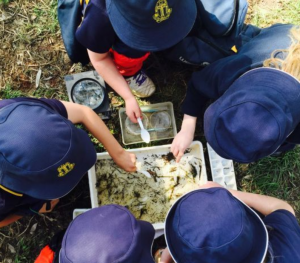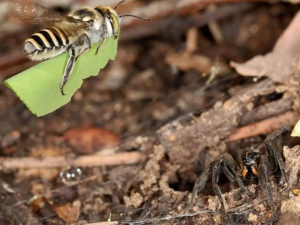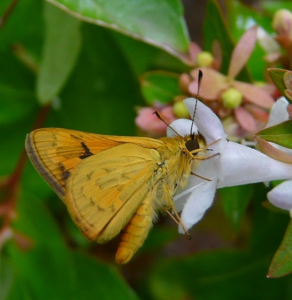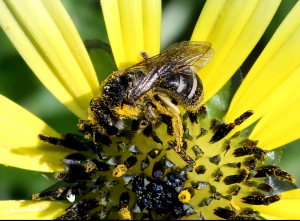BowerBird origins
 Back in 2007 – when Bowerbird.org.au hatched – if you found an unusual looking creature in your backyard and wanted to know what it was, your best bet was to take it to your closest natural history museum, find an expert and ask them directly. It’s this type of interaction that Dr Ken Walker from Museums Victoria valued, and that inspired him.
Back in 2007 – when Bowerbird.org.au hatched – if you found an unusual looking creature in your backyard and wanted to know what it was, your best bet was to take it to your closest natural history museum, find an expert and ask them directly. It’s this type of interaction that Dr Ken Walker from Museums Victoria valued, and that inspired him.
Ken saw an opportunity in harnessing the enthusiasm and expertise of citizen scientists to build an online digital community for people to share images of backyard inhabitants and request species identification. This was the beginning of BowerBird.
“My favourite expression is ‘show me what’s in your backyard’. I love hearing about what people see and where. Our community of citizens and experts has uncovered some great secrets of the natural world,” Ken said.
Web-based biodiversity science
BowerBird – and other websites such as the global platform iNaturalist – allow new discoveries to be made and shared with the world. They have also shown how members of the public can make significant contributions to our biodiversity knowledge.
“Citizen science is now a well-accepted and valued part of natural sciences. BowerBird and its contributors have helped to secure this status,“ Ken said.
BowerBird migration to iNaturalist
As BowerBird closes, a collaborative rescue operation has been set in motion. A few active BowerBird volunteer heroes and iNaturalist staff have been busy helping almost 50 BowerBird users transfer more than half of all BowerBird records over to iNaturalist. The ALA will pick up the remainder of the records which cannot move across to an active iNaturalist user.
This is a great achievement and is an excellent celebration of BowerBird’s success. You can now see 52,652 observations BowerBird records on iNaturalist.
The same ‘rescue team’ has set up a BowerBird project within iNaturalist, to ensure that the BowerBird community will be able to continue to grow and interact with each other. Access the Bowerbird Project on iNaturalist.
“The time has come to close BowerBird, but we should all be very proud of the legacy that BowerBird contributors have built and the many lessons that citizen science has learnt from BowerBird. I do hope BowerBird users will continue to make valuable contributions to science about our natural world through iNaturalist,” Ken said.
BowerBird highlights
Ken shared with us a couple of his favourite stories of discovery and collaboration that BowerBird facilitated over the last 10 years.

Spider discovered by young citizen scientists
Students from a school in Victoria discovered a small jumping spider during a Bug Blitz field day, and we (Museums Victoria experts) verified the spider’s identification and confirmed it had never been seen in Victoria before. The kids were thrilled and so were we! Read full article

Bee and spider bedfellows in ‘world-first’ uncovered by citizen scientist
Keen amateur photographer Laurence Sanders was walking through the botanical gardens in Emerald, Queensland, to take some pictures of jumping spiders when he spotted something a little odd. Laurence took a series of photos capturing a wolf spider sharing its burrow with a leafcutter bee. He posted the images on BowerBird and it created a real buzz. After checking with experts across the world, I confirmed this was a world-first. This species interaction had never been recorded before. Read full article

Deciding what to tree to plant? Just ask the butterflies.
A group of people associated with a nature reserve somewhere on the Mornington Peninsula, wanted to replant the park with plants species about in the 1950s. So, they looked up the Butterfly dataset on Bioinformatics (the precursor to Bowerbird). They used the map grid query system, which also allowed users to select either a month or decade to query. This allowed them to ask: ‘What species of butterflies occurred in the Mornington Peninsula in the 1950s?’ From the results, they found food plant data per species, and began to compile a species planting guide for their nature reserve. The result was a list of plants that were eaten by butterfly caterpillars recorded in their area in the 1950s. I was stunned when they thanked me for providing such a dataset and explained how they had used the data.

Australian Native Bees
What I loved about BowerBird was that anyone could create a project and when other people joined that project and contributed image records, then a critical mass of data was built. My own project was Australian Native bees which started out with just me, but now has 524 people who have contributed over 4,000 image records from around Australia.
iNaturalist Australia
The ALA has recently joined the iNaturalist network. iNaturalist has an excellent crowd-sourced species identification system and access to a huge global network of identifiers and observers. By becoming a member of the iNaturalist Network, the ALA will have its own local node called iNaturalist Australia.
Already, all data collected and shared with iNaturalist can be viewed in the ALA. The ALA-iNaturalist collaboration will focus on using the iNaturalist platform for individual sightings in the ALA, which will mean better species identification and data quality. Over the next few months, ALA users will be encouraged to log sightings through iNaturalist Australia. If you have any questions or would like more information, contact support@ala.org.au.